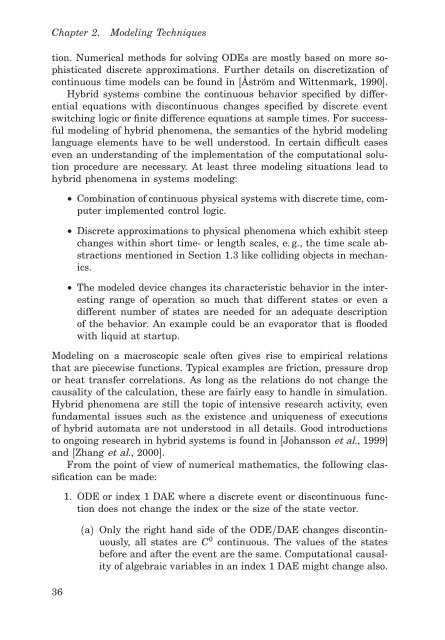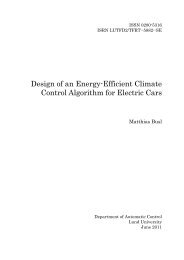Design and Implementation of Object-Oriented ... - Automatic Control
Design and Implementation of Object-Oriented ... - Automatic Control
Design and Implementation of Object-Oriented ... - Automatic Control
Create successful ePaper yourself
Turn your PDF publications into a flip-book with our unique Google optimized e-Paper software.
Chapter 2. Modeling Techniques<br />
tion. Numerical methods for solving ODEs are mostly based on more sophisticated<br />
discrete approximations. Further details on discretization <strong>of</strong><br />
continuous time models can be found in [Åström <strong>and</strong> Wittenmark, 1990].<br />
Hybrid systems combine the continuous behavior specified by differential<br />
equations with discontinuous changes specified by discrete event<br />
switching logic or finite difference equations at sample times. For successful<br />
modeling <strong>of</strong> hybrid phenomena, the semantics <strong>of</strong> the hybrid modeling<br />
language elements have to be well understood. In certain difficult cases<br />
even an underst<strong>and</strong>ing <strong>of</strong> the implementation <strong>of</strong> the computational solution<br />
procedure are necessary. At least three modeling situations lead to<br />
hybrid phenomena in systems modeling:<br />
• Combination <strong>of</strong> continuous physical systems with discrete time, computer<br />
implemented control logic.<br />
• Discrete approximations to physical phenomena which exhibit steep<br />
changes within short time- or length scales, e. g., the time scale abstractions<br />
mentioned in Section 1.3 like colliding objects in mechanics.<br />
• The modeled device changes its characteristic behavior in the interesting<br />
range <strong>of</strong> operation so much that different states or even a<br />
different number <strong>of</strong> states are needed for an adequate description<br />
<strong>of</strong> the behavior. An example could be an evaporator that is flooded<br />
with liquid at startup.<br />
Modeling on a macroscopic scale <strong>of</strong>ten gives rise to empirical relations<br />
that are piecewise functions. Typical examples are friction, pressure drop<br />
or heat transfer correlations. As long as the relations do not change the<br />
causality <strong>of</strong> the calculation, these are fairly easy to h<strong>and</strong>le in simulation.<br />
Hybrid phenomena are still the topic <strong>of</strong> intensive research activity, even<br />
fundamental issues such as the existence <strong>and</strong> uniqueness <strong>of</strong> executions<br />
<strong>of</strong> hybrid automata are not understood in all details. Good introductions<br />
to ongoing research in hybrid systems is found in [Johansson et al., 1999]<br />
<strong>and</strong> [Zhang et al., 2000].<br />
From the point <strong>of</strong> view <strong>of</strong> numerical mathematics, the following classification<br />
can be made:<br />
36<br />
1. ODE or index 1 DAE where a discrete event or discontinuous function<br />
does not change the index or the size <strong>of</strong> the state vector.<br />
(a) Only the right h<strong>and</strong> side <strong>of</strong> the ODE/DAE changes discontinuously,<br />
all states are C 0 continuous. The values <strong>of</strong> the states<br />
before <strong>and</strong> after the event are the same. Computational causality<br />
<strong>of</strong> algebraic variables in an index 1 DAE might change also.














